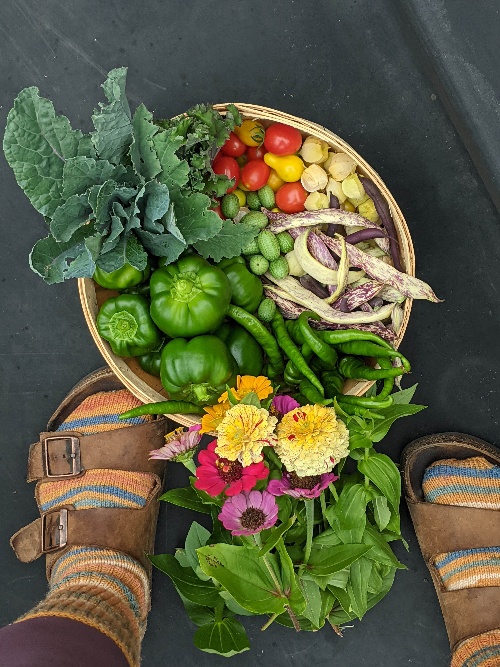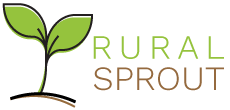
Spring is in full glorious bloom in my garden which can only mean two things:
- The hammock is coming out of storage soon and
- Not long now until we get flowers on the hydrangea shrubs.
Well, maybe a couple of months before we get full hydrangea blooms. But all the shrubs are certainly starting to leaf up. And if we want to (or need to) give them a bit of a boost this spring, now would be the perfect time to do it.

Why is fertilizing hydrangeas so complicated?
The problem with fertilizing hydrangeas, or any kind of perennial for that matter, is that it may sound a bit intimidating.
What are those numbers on the fertilizer bottle?
Should we choose granules or liquid?
When is the best time to do it? Should we do it once a year or every month?
I understand the fretful feeling around feeding these popular shrubs, and I want to show you my approach. It’s called habit stacking, and it’s something I apply in other areas of life, especially when it comes to learning a new skill.

And I think it will help with garden jobs too, whether it’s fertilizing hydrangeas or pruning perennials.
The layered approach to fertilizing perennials.
Here’s how this “if you do one thing” approach works for me:
If you do one thing (to reach your goal), then do this: mulch your hydrangeas with a layer of fresh compost
Then if you add one extra job, you can use slow-release organic fertilizer for your hydrangeas.
Finally, to level up your hydrangea fertilizing, feed your soil in addition to feeding your plants.

Did I just make it more complicated?
I hope not.
All I’m saying is that you can start learning about fertilizing shrubs in really easy mode and build up from there. You don’t have to do it all at once. And you don’t even have to do it all within the span of the same growing season.
It’s impossible to get it wrong if you start small. As you’re seeing results and gaining confidence, you’ll want to add up another skill to your tool belt.
1. Basic skill to fertilize hydrangeas: just add compost.
The easiest way you could fertilize your hydrangeas is this: apply a thick layer of finished compost at the base of the plant, all around the dripline.
It’s a really simple principle. Over time, the nutrients in the compost will feed the hydrangea.
The pros:
- You don’t have to know anything about NPK numbers or other such formulas.
- Compost is easily available. You might already be making your own.
- In addition to feeding the plants, the layer of compost will also improve the permeability of the soil, all the while maintaining the balance between water-retaining and well-draining soil.

The cons:
- It’s slow acting (as it should be) and it will take repeated applications of compost to boost the health of the plant.
- It focuses on the overall health of the plant, which might not translate into abundant blooming right away.
2. Level up: apply a slow-release organic fertilizer.
If your focus is getting a flush of rich vibrant blooms this year, adding a slow-release organic fertilizer is the surefire way to achieve that in a short span of time.
Here are a few things you should know before you do.

The pros:
It’s relatively fast-acting (yes, even slow-release fertilizer), and you’ll see results within the same growing season.
The cons:
- You have to understand some soil chemistry. (Don’t worry. I’ll explain the basics below.)
- It’s topical, so it will only feed the plant you apply it to.
- You need to repeat the application every year.
- It’s really easy to overdo it and burn your plants.
Do you know whether your soil is acidic or alkaline?
Let’s start with this basic principle. Because fertilizer is not a universal medicine that we can just “treat” soil with without knowing what the soil is missing.
There’s no simple way to know whether your soil is acidic or alkaline unless you’ve done a soil test. You can order a soil test online or send a sample to your local university agricultural extension. (It’s usually not free, but it can be more reliable than a DIY test.)

Why does soil pH matter?
Because the pH in your soil can influence not just the color of the blooms of certain hydrangeas, but the entire shrub’s overall health.
- In acidic soil (with a pH below 6.0), the hydrangea will bloom blue;
- In neutral soil (with a pH between 6.0 and 7.0), the flowers will be indigo-purple or a pleasant mix of blue and pink;
- However, in alkaline soil (with pH above 7.0), the flowers will be deep pink or red.
I’ve read the popular advice out there that says you should use the same fertilizer for your hydrangeas as you use for the plants that love acidic soil (such as blueberries or azaleas). I think you should only use fertilizer for acidic soil if you’ve done a pH test and know for sure that your soil is too alkaline.

Beyond flower colour, incorrect pH levels can limit nutrient absorption, leading to deficiencies in essential minerals such as iron, magnesium, and phosphorus.
Choose a slow-release feed.
Applying a slow-release organic feed means that the roots will absorb the nutrients over the next couple of months. As the hydrangea accelerates its growth and bloom, the feed will be in the soil ready for uptake. Slow-release is a more balanced feeding, compared to liquid fertilizer, that won’t leach away in too much rain.
It also lowers the risk of overfeeding – leading to burning or stunting your hydrangea – which is very common when gardeners apply synthetic fertilizers.

An organic fertilizer has the “OMRI Listed” logo. The Organic Materials Review Institute (OMRI) is an international nonprofit that greenlights products that are allowed in organic production. I’m not saying that it’s not organic if they don’t have the OMRI seal, but all I’m saying is that they checked, so we don’t have to.
Holly-tone and Rose-tone from Espoma are the two types of popular fertilizers for woody plants that I see recommended often in gardening communities.
How do I apply this hydrangea fertilizer?
If you’re applying granular fertilizer, simply sprinkle it all around the drip line of the plant. Then you can gently work it into the soil and water it. As the granules decompose, they will feed the hydrangea roots.

It’s important that you follow the instructions on the fertilizer label. Because not only do manufacturers use a slightly different formula, but they also conduct their own tests and field trials to determine the best use of their product.
3. Advanced skill: feed your soil for overall plant resilience.
Before you accuse me of overcomplicating things, let me assure you that I’m trying to do the opposite.
I am, at my core, a lazy gardener. And one of the best mantras that allows me to keep being lazy is this: feed your soil, not each plant.
This spring, I sat down in my garden, pen and paper in hand, and started counting. I have 80 different types of plants growing in my small suburban backyard. Not 80 different plants. 80 types!
I couldn’t possibly baby each and every one of them as I do my hydrangeas. So instead of feeding the individual plants, I’m switching my focus to feeding the soil.

There are several ways to do that, including making and spreading my own compost. But let me show you one “magic” ingredient that hydrangeas in particular seem to love: seaweed soil conditioner.
Seaweed as a soil amendment for hydrangeas.
Seaweed has been traditionally used as a soil conditioner in coastal communities for centuries. They knew that spreading it on fields and gardens and working it into the soil made the crops grow stronger and more resilient.
Seaweed fertilizer is rich in trace elements such as iron, copper, zinc, and manganese. Plants only need a small amount of these nutrients (hence the name ‘trace elements’), but they are all important to a plant’s metabolism.
I buy my seaweed in liquid form, just for ease of use. But you can also find it in dry form as a concentrated powder or seaweed meal (which is simply dried and crushed seaweed). Seaweed works really well if we apply it when the plants are in active growth, from March through September.
Have a look at this liquid seaweed extract. It is viscous, just like oil. And this bottle will last me the whole summer.

How to use seaweed soil conditioner for lush hydrangeas.
Just like with regular fertilizer, the best practice is to always read the label and follow the instructions accordingly.
In this case, the label instructs me to use one part seaweed liquid for 100 parts water. So for my two and a half gallon watering can, I’m using about one hundred milliliters of liquid.

I add this to the watering can and stir it a bit. Then I use it in lieu of regular watering at the base of the hydrangea.
The nice thing about it is that it’s also a good foliar feed, so it won’t harm the plant if the leaves get watered too.

If you’d like to try using seaweed fertilizer for your plants, this Bloom City Clean Kelp Seaweed Fertilizer is the perfect choice.
What’s the best time to fertilize hydrangeas?
We can fertilize our hydrangeas just when they start leafing up. If we feed it too early in spring, when the plant is still dormant, the roots won’t absorb what they need.
Most hydrangeas will only need one application of fertilizer a year, if that. Some feed labels recommend monthly applications, but that’s a bit too much trouble for my gardening style.
If you decide to feed them monthly, keep in mind that you’ll have to stop by early July. That’s because the more we encourage new growth, the more we offset the dormancy period that the plants need to recover in order to bloom again next year.
This is even more important on old wood hydrangeas which will start forming next year’s buds in late summer and fall. If you don’t know what that means, have a look at this article in which I explain which hydrangeas grow on old wood.
The one time we shouldn’t fertilize hydrangeas.
I’ve already mentioned this in my article on how to plant a hydrangea that we don’t need to fertilize them when we put them in the ground. That’s because they will have already been fertilized before they left the nursery.

In fact, for most of them, you can see the slow release granules embedded into the potting soil. Allow it to recover and get established the first year and, if needed, you can start fertilizing the following year.
Overall, I don’t think fertilizing hydrangeas is complicated. And the more we focus on making our garden soil a nutrient-rich haven, the less we’ll need to add external fertilizers over time.

Get the famous Rural Sprout newsletter delivered to your inbox.
Join the 50,000+ gardeners who get timely gardening tutorials, tips and tasks delivered direct to their inbox.


